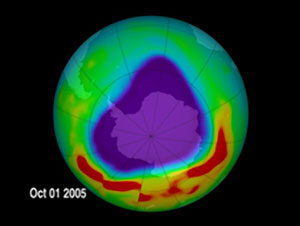Ozone Hole makes Early Appearance in 2007
Ozone Hole makes Early Appearance in 2007
By Joshua S Hill
special to mongabay.com
August 28, 2007
The Antarctic ozone hole was discovered in 1985 by British scientists Joseph Farman, Brian Gardiner, and Jonathan Shanklin of the British Antarctic Survey. Though called a hole, it is rather a location in the ozone shield — a layer that keeps ultra-violet rays from affecting us directly — that is substantially lacking in ozone concentration.
According to NASA’s Ozone Hole Watch page, “The depth and size of the Antarctic ozone hole are governed by the temperature of the stratosphere and amount of sunlight reaching the South Polar Region.”
This hole, which grows in size towards the end of every year with the onset of the Southern Hemisphere’s summer months, has appeared earlier this year, provoking speculation as to whether the hole will grow larger than 2006’s record breaking size. Geir Braathen, a senior scientific officer with the WMO’s atmospheric research and environment programme, believes that the hole could reach as far north as the tip of South America.
 This still image is from an animation that zooms down to Antarctica and shows the daily ozone readings from July 1, 2005 to October 25,2005. Credit: NASA |
According to the World Meteorological Organization (WMO) — the United Nations weather agency — it will not be clear for several weeks as to whether it will exceed last year’s size, as the conditions of the gap are based on the weather conditions below it.
“It is still too early to give a definitive statement about the development of this year’s ozone hole and the degree of ozone loss that will occur. This will, to a large extent, depend on the meteorological conditions,” the Geneva-based agency said.
“Although ozone-depleting substances are now declining slowly, there is no sign that the Antarctic ozone hole is getting smaller,” it said in a report.
While use of ozone-depleting chlorofluorocarbons (CFCs) has dropped over the past several years, the WMO and the U.N. Environment Programme believe that it will not be until 2049 that the ozone levels return to pre-1980 levels over much of Europe, North America, Asia, Australasia, Latin America and Africa.
For Antarctica though, the home to the massive gap in the ozone layer of our atmosphere, the recovery of that ozone will probably last well in to the latter half of the century.







